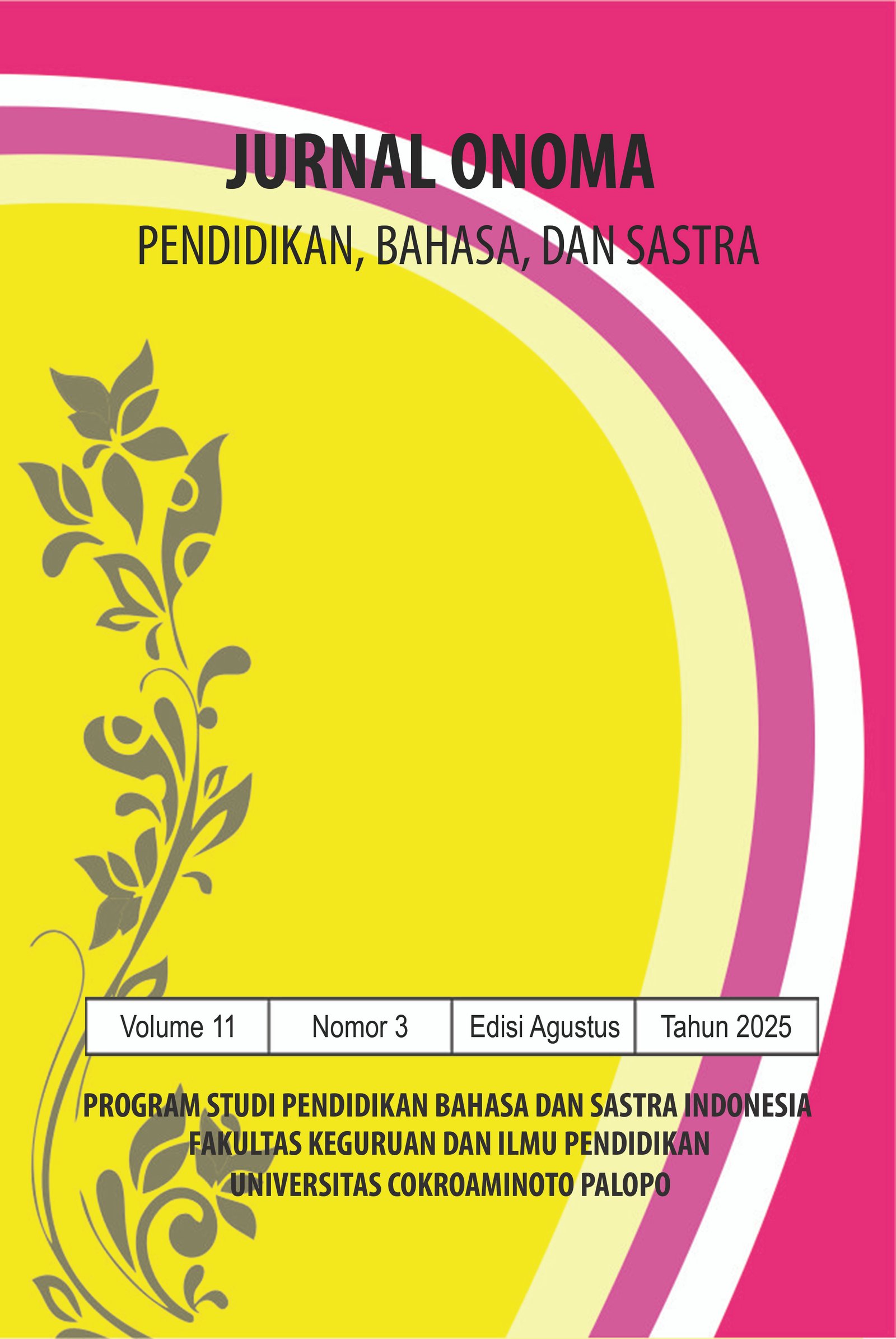Simbol Budaya dalam Lagu Nangi Dana Tambora: Kajian Antropolinguistik
https://doi.org/10.30605/onoma.v11i3.6600
Keywords:
simbol. Budaya, Lagu DaerahAbstract
Lagu Nangi Dana Tambora merupakan salah satu bentuk ekspresi budaya lisan masyarakat Bima yang merekam memori kolektif atas peristiwa letusan Gunung Tambora tahun 1815. Lagu ini mengandung simbol-simbol budaya yang mencerminkan trauma ekologis, penderitaan sosial, dan upaya rekonstruksi identitas kolektif. Penelitian ini bertujuan untuk mengidentifikasi dan menginterpretasikan simbol-simbol budaya dalam lirik lagu tersebut menggunakan pendekatan antropolinguistik. Metode yang digunakan adalah kualitatif deskriptif dengan teknik pengumpulan data berupa analisis teks, dokumentasi, dan wawancara dengan tokoh adat lokal. Hasil penelitian menunjukkan lima simbol utama: langit kelabu, asap hitam, tangisan diam, pilu rasa, dan pengulangan bait sebagai bentuk performatif budaya. Simbol-simbol ini tidak hanya merepresentasikan peristiwa bencana, tetapi juga berfungsi sebagai media penyembuhan emosional dan pelestarian nilai budaya masyarakat Bima. Lagu ini memainkan peran penting sebagai praktik budaya yang hidup, sekaligus sebagai alat artikulasi identitas, solidaritas, dan memori kolektif pascabencana. Temuan ini memperkuat relevansi pendekatan antropolinguistik dalam menganalisis warisan budaya lisan yang sarat makna sosial dan historis.
Downloads
References
Abdussamad, Z. (2021). Metode Penelitian Kualitatif. CV. syakir Media Press. DOI: https://doi.org/10.31219/osf.io/juwxn
Anas, A. (2019). Metodologi Penelitian Sastra. Graniti.
Avineri, N., Johnson, E. J., Perley, B. C., Rosa, J., & Zentella, A. C. (2021). Applied Linguistic Anthropology: Balancing Social Science with Social Change. In Extending Applied Linguistics for Social Impact. https://doi.org/10.5040/9781350136410.ch-008 DOI: https://doi.org/10.5040/9781350136410.ch-008
Creswell, J. W. (2007). Qualitative inquiry & research design : choosing among five approaches. Sage Publications.
Creswell, J. W. (2010). Research design pendekatan kualitatif, kuantitatif, dan mixed. Yogyakarta: Pustaka Pelajar.
Evayani, W., & Susanti, I. (2024). Representasi nilai budaya dalam lagu Cangget Agung masyarakat Lampung. Jurnal Antropolinguistik Indonesia, 18(1), 25–36.
Krippendorff, K. (2022). Content Analysis: An Introduction to Its Methodology (4th ed.). Sage Publications.
Kurnia, A., & Anshori, S. (2020). Sosial Humaniora Tambora Sebuah Perjalanan Visual. Jurnal Tambora, 4(1), 69–78. http://jurnal.uts.ac.id DOI: https://doi.org/10.36761/jt.v4i1.578
Muqit, F. A., Salsabila, N., & Azizah, L. (2023). Nilai budaya merantau dalam lagu Kembali Pulang karya Feby Putri: Analisis antropolinguistik. Jurnal Bahasa Dan Budaya Nusantara, 10(2), 112–123.
Nur Indah Yusari. (2021). Eksistensi Pantun Sebagai Dampak Ekologis Dan Bentuk Tradisi Ekspresif Masyarakat Melayu: Tinjauan Antropolinguistik. Jurnal Sasindo Unpam, 9, 17–34.
Rita Fiantika, F., Wasil, M., & Jumiyati, S. (2022). Metodologi Penelitian Kualitatif. www.globaleksekutifteknologi.co.id
Sibarani, R. (2020). Developing friendly city and friendly village based on local culture: An Anthropolinguistic Study. IOP Conference Series: Earth and Environmental Science, 452(1). https://doi.org/10.1088/1755-1315/452/1/012062 DOI: https://doi.org/10.1088/1755-1315/452/1/012062
Sugiyono. (2019). Metode penelitian kualitatif, kuantitatif, dan R&D. Alfabeta.
Tektigul, Z., Bayadilova-Altybayeva, A., Sadykova, S., Iskindirova, S., Kushkimbayeva, A., & Zhumagul, D. (2023). Language is a Symbol System that Carries Culture. International Journal of Society, Culture and Language, 11(1), 203–214. https://doi.org/10.22034/IJSCL.2022.562756.2781
Zainal, A. J. (2023). Perempuan Berdaya: Memperkuat Peran Perempuan dalam Budaya Tradisional. Sosiopolitica: UIN Sunan Gunung Jati Bandung.
Downloads
Published
How to Cite
License
Copyright (c) 2025 Sri Sanaliati, Hari Windu Asrini

This work is licensed under a Creative Commons Attribution 4.0 International License.
In submitting the manuscript to the journal, the authors certify that:
- They are authorized by their co-authors to enter into these arrangements.
- The work described has not been formally published before, except in the form of an abstract or as part of a published lecture, review, thesis, or overlay journal.
- That it is not under consideration for publication elsewhere,
- That its publication has been approved by all the author(s) and by the responsible authorities – tacitly or explicitly – of the institutes where the work has been carried out.
- They secure the right to reproduce any material that has already been published or copyrighted elsewhere.
- They agree to the following license and copyright agreement.
License and Copyright Agreement
Authors who publish with Onoma Journal: Education, Languages??, and Literature agree to the following terms:
- Authors retain copyright and grant the journal right of first publication with the work simultaneously licensed under Creative Commons Attribution License (CC BY 4.0) that allows others to share the work with an acknowledgment of the work's authorship and initial publication in this journal.
- Authors are able to enter into separate, additional contractual arrangements for the non-exclusive distribution of the journal's published version of the work (e.g., post it to an institutional repository or publish it in a book), with an acknowledgment of its initial publication in this journal.
- Authors are permitted and encouraged to post their work online (e.g., in institutional repositories or on their website) prior to and during the submission process, as it can lead to productive exchanges, as well as earlier and greater citation of published work.

















